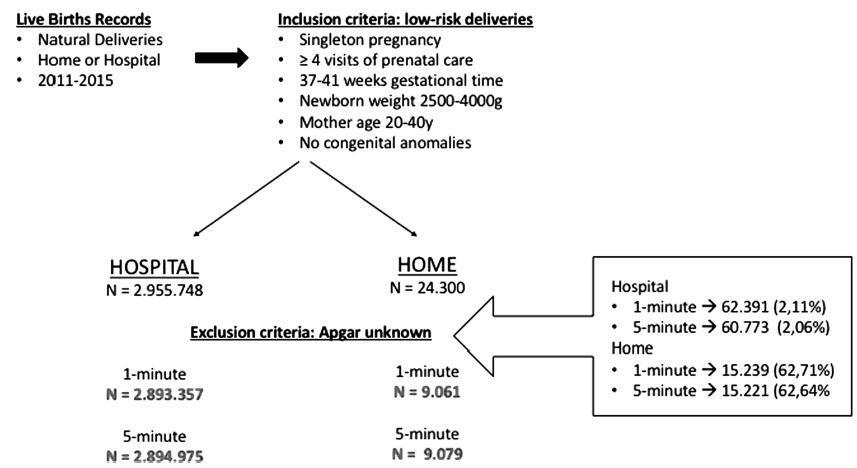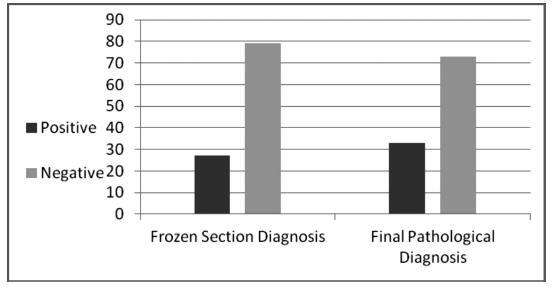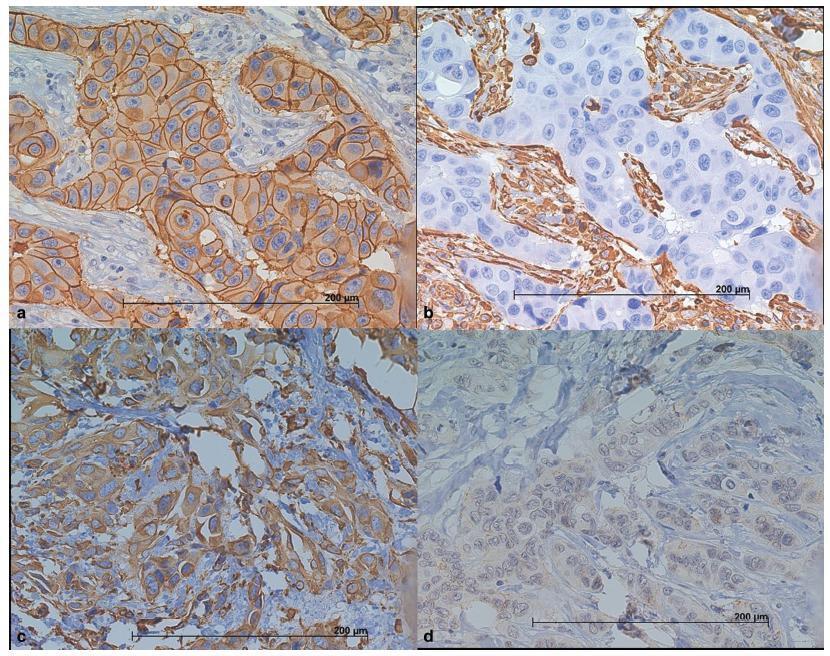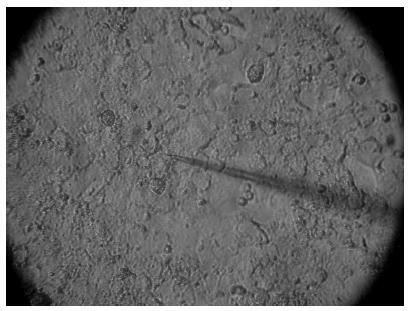Summary
Revista Brasileira de Ginecologia e Obstetrícia. 2019;41(2):76-83
To promote informed choice for women and to compare home andhospital births in relation to the Apgar score.
Mother’s profile and Apgar score of naturally born infants (without forceps assistance) in Brazil between 2011 and 2015, in both settings-hospital or home-were collected from live birth records provided by the Informatics Department of the Unified Health System (DATASUS, in the Portuguese acronym). For the analysis, were included only data fromlow-riskdeliveries, including gestational time between 37 and 41weeks, singleton pregnancy, at least four visits of prenatal care, infants weighing between 2,500 g, and 4,000 g, mother age between 20-40 years old, and absence of congenital anomalies.
Home birth infants presented significantly higher risk of 0-5 Apgar scores, both in 1 minute (6.4% versus 3%, odds ratio [OR] = 2.2, confidence interval [CI] IC 2-2.4) and in 5 minutes (4.8% versus0.4%,OR = 11.5,CI 10.5-12.7). Another findingis related to recovery estimateswhen from an initially bad 1-minute Apgar (<6) to a subsequently better 5-minute Apgar (> 6). In this scenario, home infants had poorer recovery, Apgar scorewas persistently < 6 throughout the fifth minute in most cases (71% versus 10.7%, OR 20.4, CI 17-24.6).
The results show worse Apgar scores for babies born at home, compared with those born at the hospital setting. This is a pioneer and preliminary study that brings attention concerning differences in Apgar score related to home versus hospital place of birth in Brazil.

Summary
Revista Brasileira de Ginecologia e Obstetrícia. 2019;41(3):142-146
Frozen section examination is a rapid method for identifying products of conception in endometrial curetting, yet its accuracy is inconclusive. The purposes of this study is to determine the accuracy of frozen section analysis of endometrial curetting in pregnancies of unknown location, and to verify the relation of β-human chorionic gonadotrophin (hCG) level and endometrial thickness to the assessed accuracy.
We reviewed data from January 2009 to December 2014 of diagnostic curettages from women with suspected ectopic pregnancies sent for frozen section examination at a medical center. A frozen section diagnosis was considered accurate if it concurred with the final pathologic diagnosis.
Of 106 frozen section studies, the diagnosis was accurate in 94 (88.7%). Of 79 specimens interpreted as negative on frozen sections (no products of conception noted), 9 (11.4%) were positive on final pathologic review. Three of the 27 (11.1%) specimens interpreted as positive by a frozen section failed to demonstrate products of conception on a final pathologic section. The sensitivity of frozen sections in the diagnosis of ectopic pregnancy was 72.7%, specificity 95.9%, positive predictive value 88.9%, negative predictive value 88.6%, and accuracy 88.6%. A statically significant correlation was found between β-hCG level and high accuracy of the frozen section technique (p< 0.001). No correlation was found between endometrial thickness and the accuracy of the frozen section technique.
The accuracy of frozen section examination was high and was found to correlate with β-hCG level, but not with endometrial thickness.

Summary
Revista Brasileira de Ginecologia e Obstetrícia. 2018;40(12):779-786
The use of molecular markers can identify a subgroup of tumors with distinct recurrence patterns. The present study aimed to characterize the immunohistochemical expression of vimentin (VIM), of E-cadherin (CDH1), and of cytokeratin 5 (CK5) in patients with invasive ductal carcinomas (IDCs).
We have constructed a tissuemicroarray (TMA) from87 patients with IDC of the breast. Immunohistochemistry (IHC) was performed to study the expression of estrogen and progesterone receptors (ER and PgR), human epidermal growth factor receptor 2 (HER2), VIM, CDH1, CK5, and Ki67. The tumors were classified as luminal A and B (n = 39), HER2 enriched (n = 25), and triple-negative (TNBC) (n = 23), based on the IHC expression.
We have observed that luminal A and B tumors lack the VIM+/CDH1-/low phenotype. This phenotype was observed in 16.5% of the HER2+ tumors and in 60% of the TNBC tumors (p = 0.0001). Out of a total of 20 TNBC tumors, the CK5 (basal-like marker) was positive in 11 of them. The VIM+/CDH1-/low phenotype was observed in 5 CK5+ TNBC tumors (45%) and in 7 out of 9 CK5- TNBC tumors (78%) (p = 0.02). The median Ki67 index in the VIM+/CDH1-/low tumors was 13.6 (range: 17.8-45.4) compared with 9.8 (range: 4.1-38.1) in other tumors (p = 0.0007). The presence of lymph nodemetastasis was less frequent in patients with VIM+/CDH1-/low tumors (23% versus 61%; X2 test; p = 0.01).
Our findings suggest that the expression of VIM and CDH1 can identify a subset of IDCs of the breast with a mesenchymal phenotype associated with poor prognosis, high-grade lesion, and high mitotic index.

Summary
Revista Brasileira de Ginecologia e Obstetrícia. 2018;40(12):771-778
To assess the sexual function, anxiety, and depression of infertile women relative to a control group.
Infertile women (infertile group, IG) of reproductive age were invited to participate in this controlled study. A control group (CG) of women was recruited from the general population of the same city. Sexual function was assessed by the Female Sexual Function Index (FSFI), and anxiety and depression were measured by the Hospital Anxiety and Depression Scale (HADS).
A total of 280 women participated in the present study, 140 in the IG and 140 in the CG. The analysis of the FSFI scores showed that 47 women (33.57%) in the IG and 49 women (35%) in the CG had sexual dysfunction (FSFI ≤ 26.55; p = 0.90). Women with anxiety or depression had a greater risk of sexual dysfunction, and sexual dysfunction increased the risk of anxiety and depression. Married women had a lower risk of depression than single women who were living with their partners.
Infertilewomenhadno increased riskof sexual dysfunction relativetocontrols. Anxiety and depression increased the risk of sexual dysfunction in the studied population.

Summary
Revista Brasileira de Ginecologia e Obstetrícia. 2018;40(12):763-770
The aim of the present study was to provide a better understanding of the specific action of two follicle-stimulating hormone (FSH) isoforms (β-follitropin and sheep FSH) on the membrane potential of human cumulus cells.
Electrophysiological data were associated with the characteristics of the patient, such as age and cause of infertility. The membrane potential of cumulus cells was recorded with borosilicate microelectrodes filled with KCl (3 M) with tip resistance of 15 to 25 MΩ. Sheep FSH and β-follitropin were topically administered onto the cells after stabilization of the resting potential for at least 5 minutes.
In cumulus cells, the mean resting membrane potential was - 34.02 ± 2.04 mV (n = 14). The mean membrane resistance was 16.5 ± 1.8 MΩ (n = 14). Sheep FSH (4 mUI/mL) and β-follitropin (4 mUI/mL) produced depolarization in the membrane potential 180 and 120 seconds after the administration of the hormone, respectively.
Both FSH isoforms induced similar depolarization patterns, but β-follitropin presented a faster response. A better understanding of the differences of the effects of FSH isoforms on cell membrane potential shall contribute to improve the use of gonadotrophins in fertility treatments.

Summary
Revista Brasileira de Ginecologia e Obstetrícia. 2018;40(12):757-762
To evaluate whether the circulating level of tissue inhibitor of metalloproteinase- 4 (TIMP-4) in the period between 20 and 25 weeks of gestation is a predictor of preeclampsia.
We have performed a case-control study, nested in a prospective study cohort in Ribeirão Preto, in the state of São Paulo, Brazil. Of the 1,400 pregnant women evaluated between 20 and 25 weeks of gestation, 460 delivered in hospitals outside of our institution. Of the 940 pregnant women who completed the protocol, 30 developed preeclampsia. Healthy pregnant women (controls, n = 90) were randomly selected from the remaining 910 participants. From blood samples collected between 20 and 25 weeks of gestation, we performed a screening of 55 angiogenesis-related proteins in 4 cases and 4 controls. The protein TIMP-4 was the most differentially expressed between cases and controls. Therefore, wemeasured this protein in all cases (n = 30) and controls selected (n = 90).
There were no differences in the plasma TIMP-4 levels of cases compared with controls (1,144 263 versus 1,160 362 pg/mL, respectively; p > 0.05).
Plasma TIMP-4 levels were not altered at 20 to 25 weeks of gestation, before the manifestation of clinical symptoms; therefore, they are not good predictors of the development of preeclampsia.

Summary
Revista Brasileira de Ginecologia e Obstetrícia. 2018;40(12):749-756
To describe caffeine consumption during pregnancy and its association with low birth weight (LBW) and preterm birth in the birth cohort of Ribeirão Preto, state of São Paulo, Brazil, in 2010.
Cohort study, with descriptive and analytical approach. Data included 7,607 women and their newborns in Ribeirão Preto, state of São Paulo, Brazil. The women answered standardized questionnaires about reproductive health, prenatal care, life habits, sociodemographic conditions, and information about coffee intake. The independent variable was high caffeine consumption (≥300 mg/day) from coffee during pregnancy, and the dependent variables were LBW (birth weight < 2,500 g) and preterm birth (< 37 weeks of gestational age). Four adjusted polytomous logistic regression models, relative risk (RR) and 95% confidence interval (CI) were fitted: biological and sociodemographic conditions; obstetric history; current gestational conditions; and all variables included in the previous models.
A total of 4,908 (64.5%) mothers consumed caffeine, 143 (2.9%) of whom reported high consumption. High caffeine intake was significantly associated with reduced education and with the occupation of the head of the family, nonwhite skin color, not having a partner, higher parity, previous abortion and preterm birth, urinary tract infection, threatened abortion, alcohol consumption and smoking. No association was found between high caffeine consumption and LBW or preterm birth in both
In this cohort, high caffeine intake was lower than in other studies and no association with LBW or preterm birth was found.
Summary
Revista Brasileira de Ginecologia e Obstetrícia. 2018;40(12):740-748
To analyze if umbilical artery pH (pHua) ≤7.00 and umbilical artery blood deficit (BDua) ≥12.00 mmol/L are good predictors of adverse neonatal outcomes.
This was an observational, longitudinal and retrospective cohort study, conducted at the department of obstetrics and gynecology of Centro Hospitalar Tondela Viseu between September 2013 and September 2015. Total cohort and subgroup analysis were performed: group A-women with umbilical cord blood gas analysis (UCBGA) performed for non-reassuring fetal cardiotocographic patterns, placental abruption, or shoulder dystocia; and group B-all the others. Assays were made with the software SPSS for Windows, Versions 20.0 and 21.0 (IBM Corp., Armonk, NY, USA).
A total of 428 UCBGAs met the inclusion criteria. The group analysis revealed an association between group A and pHua ≤7.00, as well as between BDua ≥12.00 mmol/L and 1st minute Apgar score ≤4 (p = 0.011). After the application of the logistic regression models in the total cohort analysis, pHua ≤7.00 had an impact in the occurrence of acute neonatal hypoxia (odds ratio [OR]: 6.71; 95% confidence interval [CI]: 1.21-37.06; p = 0.029); multiparous women had a higher risk of delivering a newborn with first minute Apgar score ≤4 and acute neonatal hypoxia (OR: 5.38; 95% CI: 1.35-21.43; p = 0.017; and OR: 2.66; 95% CI: 1.03-6.89, p = 0.043, respectively); women who had urologic problems during pregnancy had a higher risk of delivering a newborn with 5th minute Apgar score ≤7 (OR: 15.17; 95% CI: 1.29-177.99; p = 0.030); and shoulder dystocia represented a 15 times higher risk of acute neonatal hypoxia (OR: 14.82; 95% CI: 2.20-99.60; p = 0.006).
The pHua and the BDua are predictors of adverse neonatal outcome, and UCBGA is a useful tool for screening newborns at risk. Universal UCBGA should be considered for all deliveries, as it is an accurate screening test for neonatal hypoxia.
